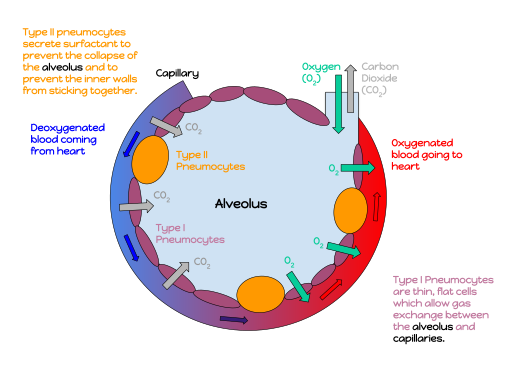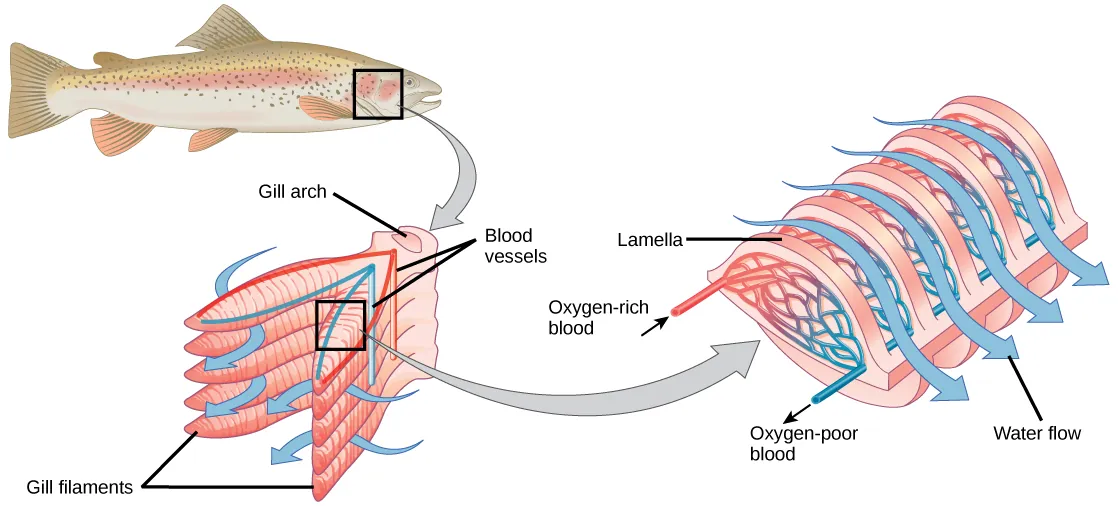OCR Specification focus:
‘Efficient exchange surfaces have increased surface area, very thin diffusion distances, and a maintained concentration gradient via good blood supply or ventilation.’
Efficient exchange surfaces enable rapid movement of substances like oxygen, carbon dioxide, and nutrients between organisms and their environments. Their structural adaptations ensure diffusion occurs quickly and continuously.
Principles of Efficient Exchange Surfaces
The Importance of Diffusion
Diffusion is the passive movement of molecules from an area of high concentration to low concentration, down a concentration gradient. The rate of diffusion is vital for processes like gas exchange, nutrient absorption, and waste removal.
Diffusion: The passive movement of particles from a region of higher concentration to a region of lower concentration, down a concentration gradient.
The efficiency of diffusion depends on several factors: surface area, diffusion distance, and concentration gradient. Organisms have evolved specialised structures that optimise all three.
Increased Surface Area
Role of Large Surface Area
A large surface area allows more molecules to diffuse at the same time. This adaptation compensates for the small surface area to volume (SA:V) ratio that occurs as organisms grow larger.
In multicellular organisms, exchange surfaces are often folded or branched to maximise area. Examples include:
Alveoli in mammalian lungs – millions of tiny air sacs increase surface area for gas exchange.
Root hair cells in plants – long extensions absorb more water and mineral ions.
Gill lamellae in fish – thin, flat structures that extend the surface for oxygen uptake.
Each of these structures ensures the exchange of materials meets the organism’s metabolic demands efficiently.
Thin Diffusion Distance
Importance of Minimising Distance
For diffusion to occur rapidly, the pathway must be as short as possible. The shorter the distance, the faster molecules move between internal and external environments.
In many systems, exchange surfaces are only one cell thick, minimising the distance for gases or solutes to travel.
Examples include:
The alveolar epithelium in the lungs and the capillary endothelium are both one cell thick, reducing the distance for oxygen and carbon dioxide diffusion.

Labeled diagram of a pulmonary alveolus showing its close association with a capillary bed. Type I pneumocytes form the thin exchange surface, while Type II cells secrete surfactant to prevent collapse. This clean layout emphasises thin barriers and high surface area; surfactant labelling adds minor extra detail beyond the syllabus. Source.
Single-celled organisms, such as amoebae, rely entirely on their thin surface membrane for gas exchange due to their small size.
Diffusion distance: The length of the pathway through which a molecule must travel during diffusion; shorter distances increase diffusion rate.
This structural adaptation is particularly vital in maintaining rapid exchange rates in organisms with high metabolic activity.
Maintaining a Concentration Gradient
Continuous Exchange Flow
A concentration gradient must be maintained to ensure diffusion continues effectively. Without it, diffusion would cease once equilibrium is reached. Organisms achieve this through movement of fluids — air, blood, or water — across exchange surfaces.
There are two primary biological mechanisms:
Circulatory systems – carry substances to and from exchange surfaces to maintain steep gradients.
Ventilation mechanisms – move respiratory gases in and out, ensuring concentrations remain unequal across the surface.
In Mammals
In the lungs, oxygen diffuses into the blood and carbon dioxide diffuses out. The blood flow through capillaries and ventilation of alveoli both sustain concentration gradients.
Ventilation continuously supplies fresh air high in oxygen and removes air high in carbon dioxide.
Circulation transports oxygenated blood away from the lungs and returns deoxygenated blood.
Together, these ensure that oxygen partial pressure remains higher in alveolar air than in blood, driving diffusion.
In Fish
In bony fish, a countercurrent flow system operates in the gills.

Diagram of a fish gill showing countercurrent flow, where water and blood move in opposite directions across lamellae. This arrangement maintains a high oxygen gradient along the entire exchange surface, maximising diffusion efficiency. Labels are clear and consistent with OCR terminology. Source.
Water and blood flow in opposite directions across the lamellae, maintaining a steep oxygen gradient along the entire exchange surface. This ensures maximum oxygen uptake even when water oxygen content is low.
In Insects
In insects, the tracheal system maintains gradients by allowing gases to diffuse directly between spiracles and cells. Rhythmic body movements ventilate air through the system, keeping oxygen levels high near the spiracles and low in tissues.
Key Structural and Functional Adaptations
Characteristics of an Efficient Exchange Surface
Efficient surfaces typically share these features:
Large surface area – increases the amount of material that can diffuse simultaneously.
Thin barrier – reduces diffusion distance for rapid exchange.
Good blood supply or ventilation – maintains steep concentration gradients.
Moist surfaces – allow gases to dissolve before diffusion, essential for exchange in both terrestrial and aquatic organisms.
Examples in Context
Human alveoli: Spherical shape and extensive capillary network optimise surface area and diffusion distance.
Fish gills: Lamellae structure with countercurrent flow maintains gradients and maximises gas uptake.
Insect tracheae: Direct delivery of oxygen to tissues through branching tubes avoids limitations of circulatory diffusion.
Plant mesophyll: Air spaces in leaves allow gases to diffuse between stomata and photosynthetic cells efficiently.
Each of these examples demonstrates how structure supports function according to the same biological principles.
Quantitative Understanding
Although not expressed numerically in the specification, diffusion efficiency can be understood through Fick’s Law, which relates diffusion rate to surface area, concentration difference, and diffusion distance.
EQUATION
—-----------------------------------------------------------------
Fick’s Law (Rate of Diffusion) = (Surface Area × Concentration Difference) / Diffusion Distance
Rate of Diffusion = Speed at which substances move across a membrane (no units specified here)
Surface Area = Total area available for diffusion (m²)
Concentration Difference = Gradient between two regions (mol m⁻³)
Diffusion Distance = Thickness of the barrier (m)
—-----------------------------------------------------------------
This relationship illustrates why efficient exchange surfaces have large surface areas, thin barriers, and maintained gradients — each directly maximising diffusion rate.
Integration of Structural Features
Coordinated Function
In multicellular organisms, efficient exchange requires coordination among various structures. For instance:
Ciliated epithelium in airways helps move mucus and trapped particles, keeping pathways clear for diffusion.
Elastic fibres in alveoli aid recoil during exhalation, assisting ventilation and maintaining airflow.
Capillary networks ensure close proximity between blood and exchange surfaces, sustaining rapid diffusion.
Such integration demonstrates how structure, function, and physiology combine to sustain life processes dependent on exchange.
FAQ
Gases must dissolve in water before they can diffuse through membranes. Moisture on the exchange surface allows oxygen and carbon dioxide to dissolve, forming a medium that facilitates diffusion through cell membranes.
If a surface becomes too dry, as in terrestrial organisms without protection, diffusion efficiency decreases sharply. Structures such as mucus layers in lungs and moist tracheal endings in insects ensure gas exchange remains effective in air.
Efficiency varies depending on how much oxygen is available in the water and the organism’s activity level.
Fish living in oxygen-poor water often have more gill lamellae to increase surface area.
Amphibians, which rely partly on skin for gas exchange, have thinner but less extensive surfaces.
Lower oxygen content in water compared to air means aquatic organisms must evolve highly specialised surfaces to maintain diffusion efficiency.
Diffusion is a passive process that relies on concentration gradients, requiring no metabolic energy. It is used for gases like oxygen and carbon dioxide.
Active transport, on the other hand, requires ATP and moves substances against their concentration gradients. While not typical for gases, it’s used in certain ion or nutrient exchanges near membranes that also serve as gas exchange surfaces, maintaining optimal cellular conditions for diffusion.
Each alveolus is tiny, but the lungs contain around 300 million alveoli, collectively providing about 70 m² of surface area — roughly the size of a tennis court.
Their spherical shape maximises area-to-volume ratio, and elastic fibres allow expansion during inhalation. Damage from diseases such as emphysema reduces total surface area by destroying alveolar walls, directly lowering diffusion efficiency.
Several external conditions can alter diffusion efficiency:
Temperature: Higher temperatures increase molecular kinetic energy, raising diffusion rates.
Humidity: In dry air, moisture loss can reduce surface effectiveness, especially in terrestrial organisms.
Oxygen concentration: Low ambient oxygen decreases the diffusion gradient, slowing gas uptake.
Pollutants: Substances like smoke or particulates can damage or thicken the exchange surface, increasing diffusion distance and reducing efficiency.
These factors influence how well organisms maintain optimal gas exchange under varying environments.
Practice Questions
Question 1 (2 marks)
Explain how the thickness of an exchange surface affects the rate of diffusion in organisms.
Mark scheme:
1 mark for identifying that a thinner exchange surface results in a shorter diffusion distance.
1 mark for explaining that this increases the rate of diffusion, as molecules travel a shorter path between areas of high and low concentration.
Question 2 (5 marks)
Describe and explain how three structural features of an efficient gas exchange surface contribute to rapid diffusion in organisms.
Mark scheme:
Award 1 mark for each correctly identified feature (maximum 3), and 1 additional mark for each explanation (maximum 2). Maximum 5 marks total.
Large surface area (1 mark): increases the area available for diffusion, allowing more molecules to cross at once (1 mark).
Thin barrier to diffusion (1 mark): reduces the distance molecules must travel, speeding up the rate of exchange (1 mark).
Maintained concentration gradient (1 mark): achieved through ventilation or blood flow, keeping concentrations unequal across the surface to allow continuous diffusion (1 mark).

